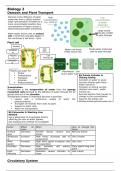Summary
CCEA GCSE Biology 2 Summary Revision Notes
CCEA GCSE Biology Unit 2 revision notes for 2016 specification. Includes detailed notes on: osmosis and plant transport, circulatory system, reproduction, fertility and contraception, DNA, cell division and genetics, variation and selection, and health, disease and defence mechanisms.
[Show more]




